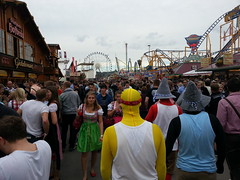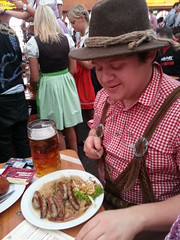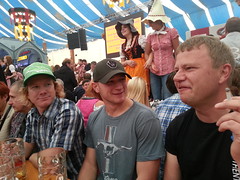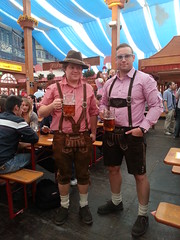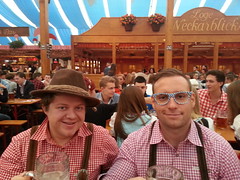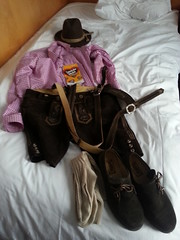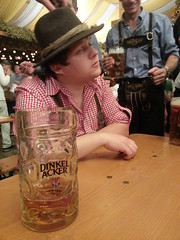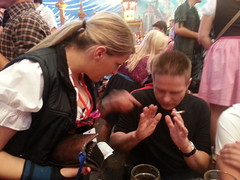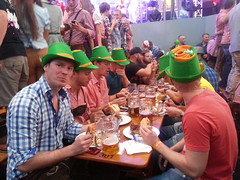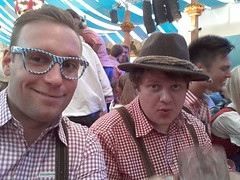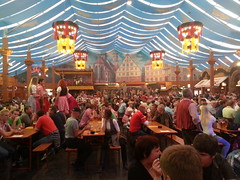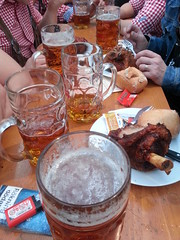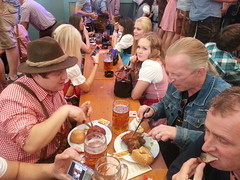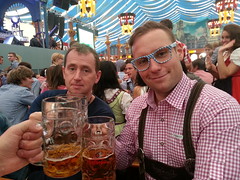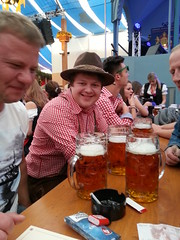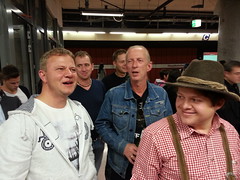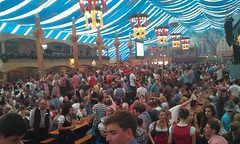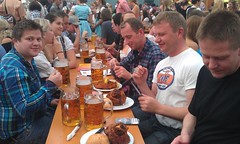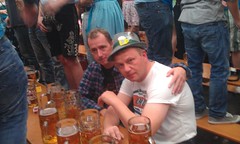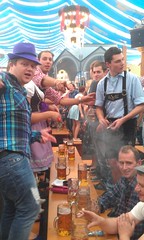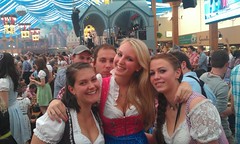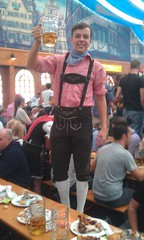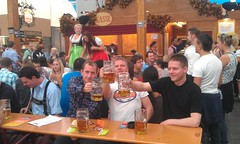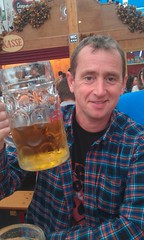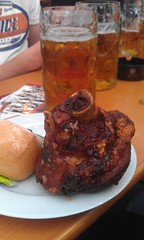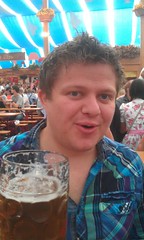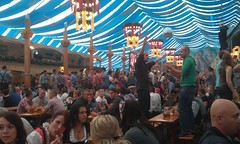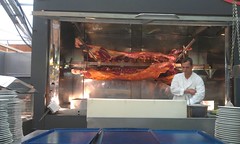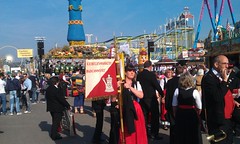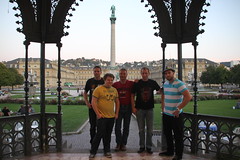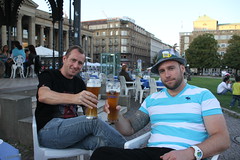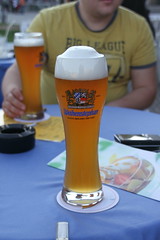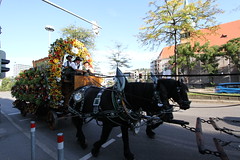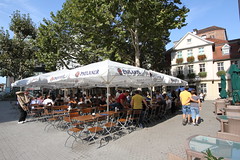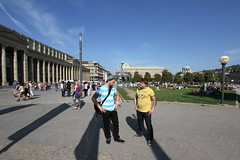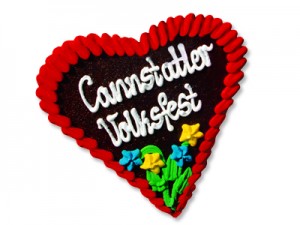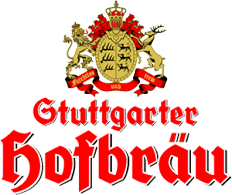A very warm welcome to the Cannstatter Volksfest. This year its the 169th Cannstatter Volksfest here in Stuttgart and it starts today the 26th of September and lasts to the 12th of oktober.
The Cannstatter Volksfest is an annual 16 day festival in Stuttgart, Germany. It is sometimes also referred to by foreign visitors as the Stuttgart Beer Festival, although it is actually more of an autumnal fair. Locals to Stuttgart variously refer to the festival as the Cannstatter wasen or just Wasen. The Volksfest takes place from late September to early October, ending the second Sunday in October. It’s held on an area called the Cannstatter Wasen. The extensive Wasen area is located in the Stuttgart city district of Bad Cannstatt near the river Neckar. Although the Volksfest is not strictly speaking a beer festival, it is considered by many to be the second largest beer celebration in the world after the Munich Oktoberfest. According to estimates about 4 million people visit the festival each year. The Volksfest begins one week later than the Oktoberfest.
History:
Colorful flashing lights, the squealing and rattling of unknown machines, the smell of burned almonds, “Göckele” (roasted chicken) and stockfish affects all your senses. Above the noise you can hear the bandmaster shouting out typical slogans like “die Krüge hoch”. No doubt, it’s “Volksfest” time in Bad Cannstatt. Annually around four million festival people gather at the biggest carnival festival in the world since 1818.
In 1815 a gigantic eruption of the Vulcano Tambora in Indonesia led to a climatic catastrophe even in Europe. The incredible explosion hurled around 100 cubic km of rocks, ashes and dust up to 70 km high and darkened the sky. The blast equalled to 170.000 Hiroshima bombs. The shockwave could be felt 1.500 km away. 10.000 people died due to the eruption. Another 100.000 died because of the aftermath. The dust particles were distributed by the jet stream around the world and caused crop failure and famine in Europe.
The winter of 1815/16 in Wurttemberg was the coldest since weather records were kept. Snow until May, no summer, alternating rain, whipping hail and thunderstorms continued into the growth season. This made bringing in a harvest in those years not possible. Throughout Germany, people were starving. The little existing flour was stretched with sawdust and the planted potatoes were dug up again. The need of the people was indescribable.
When Wilhelm I. became King of Wurttemberg in 1816, the crisis of the people couldn’t be any worse. His brother in law, Czar Nikolaus of Russia, helped him to relieve the biggest misery with deliveries of grain.
Then, in 1817, when the first harvest wagon was brought in, King Wilhelm and his Russian wife Katharina had the glorious idea to sponsor a harvest festival. This should take place annually on the King’s birthday on September, 28th in the area of the Cannstatter Wasen.
The first festival in 1818 lasted one day and had more than 30,000 visitors. At the time the village of Cannstatt had a population of 3000. The Royal Couple donated cash prizes and honorary awards for outstanding agricultural accomplishment. The festival was designed to encourage the farmers.
At the same time the popular monarch couple established an agricultural school in Hohenheim Palace. This set the foundation for today’s agricultural university. Due to this and other outstanding efforts the young monarch was titled “King of the farmers” and “Farmer amongst kings”. In the German Agricultural Museum many of the developments, e.g. the double bladed plow, can still be seen.
The most important activities of the festival had been the award for breeding performance and the display of agricultural efficiency of the Wurttemberg farmers. The first food shops and carnies showed up with the first festival. The vendors attracted the people with sauerkraut, sausage and a lot of sweet fancy foods. A market completed the culinary choices. The carnies presented the strongest men, the fattest women and a lot of other curiosities. Through the years the festival grew larger and larger and transformed from the “Agricultural festival of Kannstadt” to the “Cannstatter Volksfest”.
During the 19th century the first festival lasted one day, by 1920 it was extended to five days and since 1972 the Volksfest has been celebrated for 16 days.
In the beginning, there had only been a few Volksfest-carnies and beer counters. They were moved to the edge of the festival in favour of the royal lounge and the stand for the dignitaries. In 1860 the layout of the festival was three main streets and numerous side streets to handle the yearly increasing crowds. Today with around 350 companies, the Cannstatter Volksfest is the biggest carnival-festival worldwide. 4 to 5 million visitors are attracted to it.
King Wilhelm assigned his royal builder Nikolaus Thouret to create an emblem next to the royal lounge in the middle of the festival areal. He created the fruit pillar as a symbol for thanksgiving which is still the emblem of the Volksfest. Placed on top of the 23 m high pillar sits a bowl with fruits. Only the highest mobile Ferris wheels of the world is towering above it.
Today, the parade on the first festival Sunday is one of the most popular events of the Canstatter Volksfest. Nearly one hundred historical groups of town militia, Shepard-dancing-groups, festival wagons representing different crafts, groups dressed in traditional clothing and groups of musicians, create this colorful “Lindworm”. There are still groups in traditional clothes and professional period groups, which have taken part in the festival since 1841.
More information here:
More pictures here: (pictures taken are from the festival in 2011 and 2012)




